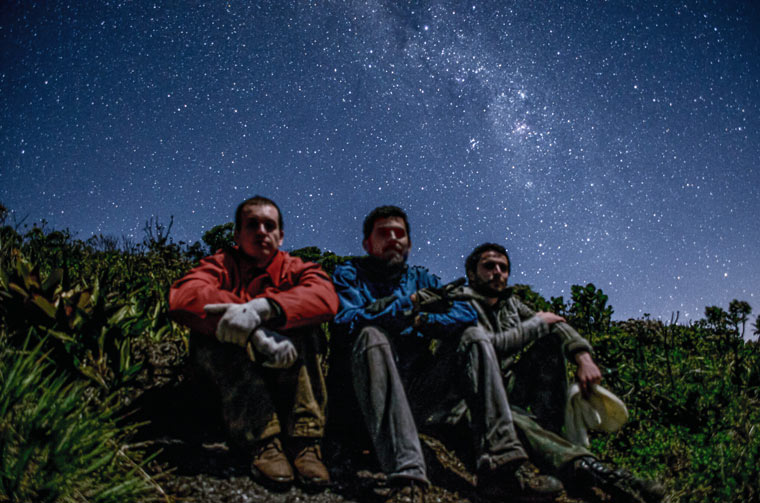Touching the stars atop the peak of “Pedra do Desengano”, which gives the park its name. Featured from left to right: Diego Nascimento, Samir Mansur and Naby Mansur. Photo credit: Samir Mansur.
SANTA MARIA MADALENA, Rio de Janeiro, Brazil — Desengano State Park (PED), administered by the State Environmental Institute (Inea), achieved an unprecedented title in Latin America: the nomination of the protected area as an International Dark Sky Park designated by the International Dark-Sky Association (IDA). The PED is already recognized internationally as a priority area for the conservation of the biodiversity of birds (Important Bird and Biodiversity Area – IBA) and now gains another international certification.
The title recognizes Desengano State Park, in Northern Fluminense, as a protected area of exceptional quality for the observation of starry nights and a protected night environment that values its scientific, natural, educational, cultural and social heritage.
“We are the first Park in Latin America to receive this title, and this is a great achievement for all of us at the Department of Environment and Inea. This certification is proof of the efforts of our teams to preserve our protected areas,” stated Secretary of State for the Environment, Thiago Pampolha.
“Desengano’s certification is not only a milestone for IDA by being the first International Dark Sky Place in Brazil, but it also opens new doors for dark sky opportunities across Latin America,” reflected Ashley Wilson, Director of Conservation with the IDA. “While the park boasts exquisite dark skies, the team also made sure to connect with local communities to be inspired by the night sky, as well as retrofit 100% of existing lighting on their external facilities to be dark-sky friendly with sustainable solutions. IDA commends the team at Desengano for their laudable efforts, and we are looking forward to new certifications in the future following this example.”
The process to apply for the certification took a little over a year to complete. First, the International Dark-Sky Association approved the documents and the presentation by the Desengano State Park team with the technical night sky quality specifications of the area. Then, the IDA evaluated the information about the commitments made by PED, such as activities aimed at reducing light pollution in the Park and the surrounding region, as well as good practices in night visitation, which already takes place in the park. Now, visitors looking for a perfect place to observe, study and enjoy the night sky have the opportunity in the State of Rio de Janeiro.
“In addition to the daytime trails and activities, we now open a new possibility to expand the population’s contact with nature, which is night observation. In Desengano State Park the conditions are perfect for this, as there is no light pollution and the visitor can contemplate the sky without any equipment. This title is very deserved,” explains the president of Inea, Philipe Campello.
Environmental and cultural heritage
The Desengano State Park, the oldest state protected area in Rio de Janeiro, completed 51 years of existence this year in 2021. The Park covers parts of the municipalities of Santa Maria Madalena, São Fidélis, and Campos dos Goytacazes, and totals 1419.21 km2 of an Atlantic Forest area that is home to 82 species of mammals, 494 species of birds, 56 species of reptiles, 73 species of amphibians, and more than a thousand types of flora.
“With this international title, we will be able to contemplate the same sky that our most remote ancestors did. This is a joint achievement of the park’s technicians, the Biodiversity, Protected Areas and Ecosystem Directorate, and civil society partners, such as the North Fluminense State University and the Louis Cruls Astronomy Club”, says Carlos Dário, manager of the State Park of the Desengano.
“This title was granted after the development of technical work carried out over a little over 1 year and will serve as a precursor for other protected areas in Brazil, whose potential for star observation is similar to the PED”, says João Rafael Marins, biologist at Inea responsible for conducting the technical studies.
“As a nature photographer born in the region, I have always admired Madalena’s sky. When I joined the PED team in 2012, this admiration became such a commitment to the number of stars able to be seen inside the park”, says Samir Mansur, coordinator of the park rangers at Desengano State Park.
Tagged with dark sky, lightED